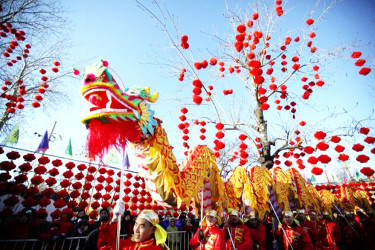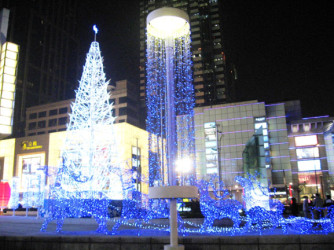Although the Christmas season has ended in Christendom, it makes such an impact, and is so influential in other parts of the world that it continues in a subterranean sense, to be a subject of interest. It is particularly interesting how, as a religious festival, it has a strong presence in non-Christian and non-Western cultures. It might be surprising to note that this extended presence, influence and ‘season’ continues elsewhere, right into January.
There is no season for cultural studies, and a cultural study of this particular religious festival is perennially rewarding. As a cultural festival, Christmas is the largest, the most popular, the most impactful and influential in the world. It has transcended its religious celebration and has become the world’s primary traditional, secular, popular and commercial festival.

This New Year connection was of special relevance to the origins of Christmas in Europe after the development of the Christian religion. (Note that, while the nativity and the teachings of Christ are core principles, other factors were involved in the creation of the festival.) Its timing coincided with other festivals, ‘pagan’ in nature, and much of its symbolism, meaning and significance, blended with both worldly and spiritual traditional beliefs connected to the New Year. These include rebirth, spiritual renewal, and a worshipful respect for evergreen plants which never die, but remain verdant through the darkest winters. (Mark, for instance, the Christmas carol ‘The Holly and The Ivy’.) The power of Christmas continued to evolve from those origins, gathering strength and creating a culture through the centuries until the present time.
One of the most enduring examples of the impact and influence of Christmas and its link to the New Year, is to be found in The Peoples Republic of China. The season is widely and deeply celebrated in that country and one may say the spirit, the interest, the fervour and the various observances have not ceased since they began at the end of November, but will continue through January.

China has a Christian population that has been quoted as one per cent of the national total. They have churches and they are said to be deep and devout in their celebration of Christmas on December 24, 25 and 26. Accounts of this mention public events such as theatrical offerings which attract a large audience, including non-Christian members of the community. Their presence and their worship, however, are not really the reason for the celebration of the season in China.
Similarly, one can understand the emphasis on Christmas in Hong Kong, which was only recently handed back to China by the British. There is a larger Christian population and the celebrations there are intense. Similarly, the greater Western significance contributes to an enthusiastic season in Taiwan and Macau. In those places both Christmas and Boxing Day are public holidays.
However, what obtains in Hong Kong, Taiwan and Macau cannot account for what happens in mainland China. Christmas is not a public holiday in the country but the festival assumes importance there. The big celebrations take place in China’s eastern provinces and in the big cities, with much less impact and awareness of it in the western regions and rural villages.
It is observed that all the international hotels are highly decorated with Christmas trees, lights and all the trimmings with seasonal music always playing in a season that starts around the end of November each year. But it is not accurate to assume that this is a token exhibition because there will always be international guests in those hotels, or that the effort is to attract a Western clientele or make them feel at home. That theory goes through the window when one observes what happens quite outside of that environment.
Throughout the streets, in all the large shops, shopping areas, parks and public places the Christmas trees are there, the lights, decorations and Santa Claus, who makes his appearance in some shops. This is also reflected in quite a bit of what is sold in shops, with one commentator remarking that most of the decorations, toys and other gadgets used in the West are made in China, anyway. China’s large cities are normally very Western in appearance and atmosphere but they emphatically outdo most Western cities with the transformation of the landscape with the glitter and trappings at Christmastime.

This happens because in China, Christmas is a very popular festival, a secular festivity and above all, a most important commercial festival. It is the most important period for making money and businesses make more sales than at any other time in the year. There is a marked contribution to the economy. Stores play Christmas music and have special sales and events; they get rid of all old stock as a custom and as a sales device; there are special offers; gifts are given to staff and to customers. Christmas Day is the grandest day for shopping when the activities reach a peak, but the commercial events will continue until January.
In addition, it is a festive time especially for young people whose sporting adventures reach a high peak. There is feasting, drinking, and parties, excursions to clubs, restaurants, parties in bars, hotels and to KTVs. It is a time as well for families and friends, exchanges, (re)unions and the giving of gifts. Places of entertainment, of special events and popular locations are at their peak particularly on December 24, with extremely large crowds. For instance in Shanghai, people ‒ mostly the younger generation ‒ will flock to the Boulevard leading to the quayside with a very colourful scenic view of the river, an area that becomes wildly overcrowded.
This level of hectic party activity and shopping is repeated for a three-day period at New Year – December to January, which is another lesser peak period. However, these may also be seen as forerunners of what is the grandest festival in China – the traditional Chinese New Year that comes a month later. It usually starts building up during the last week in January and reaches its zenith probably the end of the first week in February. In 2016 New Year’s Day will be on February 8, when China will usher in the Year of the Monkey. This current year now coming to an end is the Year of the Goat.
The Chinese enthusiasm for Christmas and New Year according to the Western calendar is probably partly prompted by the similarities between the two periods and that they come so close together. There is also kinship in the mythology, the symbolism and the messages. The traditional New Year, called the Lunar New Year, is fixed by the ancient Chinese calendar and does not fall on the same day every year. It is also called the Spring Festival and regarded as the Chinese equivalent of Christmas in terms of being the premier cultural, traditional and popular festival of the year.
Like Christmas, it is driven by myth, tradition and custom. The traditional practices, though, are more observed in rural areas and a bit less in the big cities which are quite Westernised. The Lunar New Year’s eve is a time for family reunions. Houses are thoroughly cleansed to sweep away ill fortune and make way for incoming good fortune. The period is marked by gift giving in red envelopes and places decorated largely in red. The celebrations are of good fortune, happiness, wealth and longevity. Many of the traditions arose from the myth of the origin of the Spring Festival.
It originated with the story of a mythical beast called the Nian who was in the habit of eating villagers, particularly children, and their animals. The people began preparing and placing food outside their front doors every new year so that if Nian ate the food he wouldn’t attack villagers afterwards. But one villager wanted to get rid of Nian altogether and a god told him in a dream that he should use red paper and the noise of firecrackers. It turned out that Nian was afraid of the colour red and frightened by loud noises. People then began to wear red clothing and hang red lanterns outside their houses and make loud noises with firecrackers every new year. So the beast never came back to the village and was eventually captured and subdued.
Every new year now in China, it is traditional to wear new clothes and these are acquired particularly for children. Fireworks are also used, red lanterns and the colour red are also extensively and symbolically used for decorations.
While the extensive December celebrations do not have the benefit of a public holiday, there is great generosity at the Spring Festival. There are extensive holidays of up to seven days for places of work and a whole month for students away from their studies. The messages of Christmas are very compatible with those of the Chinese New Year. So are the symbolisms of the Western New Year and those of traditional China. So that apart from the fact that Christmas as an international popular and commercial festival has made its mark upon China as it has in so many other non-Christian countries, there are some deeper reasons for its popularity in that country. The same can be said for the Western New Year, in addition to the fact that the two festivals occur conveniently within a month of each other, and have extended seasons which slightly overlap.





